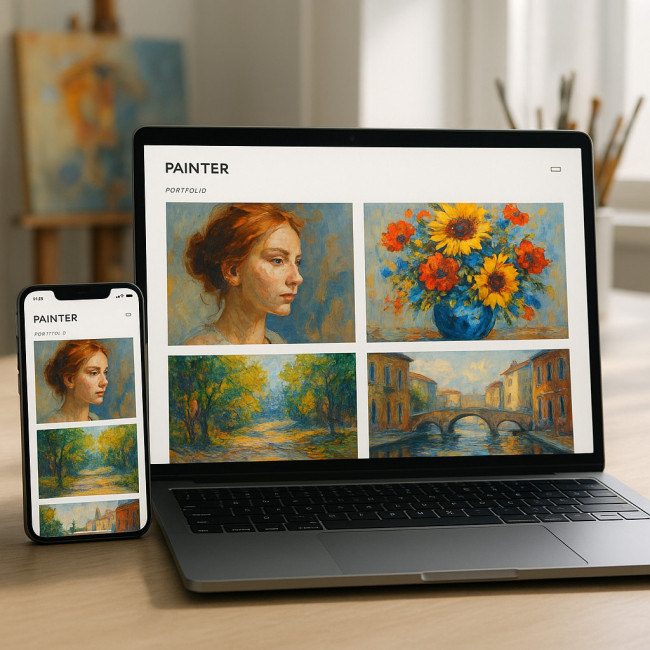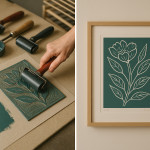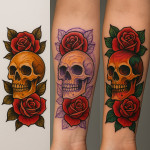Painter website refresh: selecting high-resolution images that load fast
A gallery of stunning, high-resolution images is the heartbeat of any painter's website. Yet if each file takes ages to appear, visitors bounce and curators move on. Follow this step-by-step guide to showcase razor-sharp art while keeping every page lightning-quick.
Why image quality + speed decide your next commission
Collectors, curators and agents judge your professionalism in seconds. A pixelated preview tells them you lack polish; a slow page whispers that you ignore user experience. Balancing fidelity and performance means:
- Paint strokes remain visible even on 4K and Retina screens.
- Pages pass Google's Core Web Vitals, lifting SEO rankings.
- Mobile users—now over 65 % of art-portfolio traffic—stay engaged.
Determine the perfect resolution for each artwork
1. Map your maximum display size
Inspect your theme or builder. If your hero section never exceeds 1600 px wide, there is no benefit in exporting a 4000 px file. Multiply the largest rendered width by two for Retina safety and you have the sweet spot.
2. Prioritise aspect ratio over DPI
Forget printing rules—DPI is meaningless online. Instead, export by pixel dimensions: for example, 3200 × 2400 px covers a 1600 px viewport plus Retina allowance.
Compress high-resolution images without killing texture
Lossy vs. lossless: choose per artwork
- Subtle gradients & watercolours → Lossless (PNG 24-bit or TIFF) keeps washes silky.
- Heavy acrylic texture or knife strokes → High-quality lossy (WebP 90 %) cuts weight while preserving depth.
Adopt next-gen formats
Google research shows WebP files are 25-34 % smaller than equivalent JPEGs at the same visual quality. AVIF saves up to 50 %, though browser support is still maturing. Export a fallback JPEG and let the browser pick the winner via type in the <picture></picture> tag.
Source : Google Web Fundamentals
Delivery tactics that slash loading times
Responsive srcset & sizes
Generate three to five versions per image: 320 px, 640 px, 1024 px, and your full high-resolution image. Let the browser grab only what the screen needs, saving bandwidth for mobile visitors.
Native lazy loading
Add loading="lazy" to every outside the first viewport. The browser defers downloads until the user scrolls, cutting initial payload by up to 70 %.
Preload and priority hints for hero visuals
Conversely, your banner painting should appear first. Insert <link rel="preload" as="image"> or fetchpriority="high" so browsers fetch it before JavaScript.
Cache & CDN strategy
Host images on a content delivery network; art lovers in Tokyo should not wait for a Paris server. Set Cache-Control: public, max-age=31536000, immutable and rename files on each refresh to avoid stale versions.
Workflow checklist: from studio to web
| Step | Tool suggestion | Goal |
|---|---|---|
| Color-calibrated scan or photo | DSLR + gray card | Capture true tones |
| Non-destructive edit | Adobe Camera Raw | Correct exposure |
| Resize | Photoshop “Export As” | Match 2× viewport |
| Compress | Squoosh / ImageOptim | Cut file size 30–70 % |
| Name files semantically | e.g., sunset-oil-canvas-2024.jpg | SEO friendly |
| Upload to CDN | Cloudflare Images | Global delivery |
Insert picture element | Your CMS | Serve optimal format |
Common pitfalls painters should dodge
- Uploading camera originals — A 26 MB JPEG wastes bandwidth; downsize first.
- Ignoring colour profile — Always export in sRGB for consistent display.
- Overusing PNG — Great for transparency, terrible for photos; switch to WebP.
- Forgetting alt text — Include descriptive keywords to aid accessibility and search.
- One giant gallery page — Paginate or use infinite scroll with lazy loading instead.
Related reading to deepen your optimisation
Once your images fly, ensure the rest of the site keeps pace. Discover how to optimise overall loading speed, design a mobile-first portfolio experience, and craft keyword-rich captions that charm both search engines and curators.
Quick image optimisation quiz
FAQ
- Do I need separate images for 4K screens?
- Yes. Export a file twice your maximum display width so Retina and 4K monitors render crisp brush strokes.
- Is AVIF safe to use today?
- Most modern browsers support AVIF. Provide a WebP or JPEG fallback in a
<picture></picture>element to cover older versions. - How small is too small for high-resolution images?
- If compression introduces visible banding or blurs impasto texture, raise the quality slider or switch to lossless PNG for that piece.
- What's the easiest free tool for batch conversion?
- Squoosh (web-based) and ImageOptim (Mac) both batch-compress and convert to WebP without cost.
Conclusion: let your art shine instantly

High-resolution images that load fast spell professionalism. Apply the steps above, then test your refreshed portfolio on Google PageSpeed Insights. If you crave further design inspiration, browse the latest image-focused portfolios and note their snappy feel. Ready to put theory into action? Optimise one painting now, measure the speed gain, and watch engagement climb.











